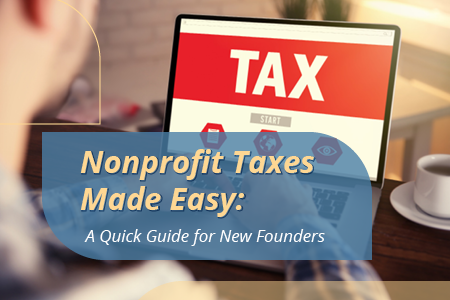
If you’re just getting started in the nonprofit management world, you might feel nervous about getting your organization’s taxes in order.
However, filing your nonprofit tax forms doesn’t have to be difficult. To get started on the right foot, it helps to understand the essentials of nonprofit taxes and how to file online. In this guide, we’ll answer the following frequently asked questions:
- What is the 501(c)(3) tax exemption?
- What are the 501(c)(3) annual filing requirements?
- How do I choose which form to complete?
- What happens if I fail to file on time?
- How do I file tax forms online?
Nonprofit tax forms are a critical component of a healthy organization, so you should know how to file them correctly and efficiently. By exploring these basic topics, you’ll be setting your organization up for continued financial success and compliance going forward. Let’s get started!
1. What is the 501(c)(3) tax exemption?
As a new nonprofit founder, you know that saving room in your budget as a nonprofit is critical. One of the most significant benefits of operating as a registered 501(c)(3) nonprofit is your exemption from many federal and state taxes.
However, you’re not automatically exempt from paying taxes by working for a charitable cause—you have to actually apply for that designation to receive the associated perks. On the federal level, you must file IRS Form 1023, which essentially outlines your nonprofit’s business plan and makes a case for why you deserve tax exemption. At the state level, registration and solicitation regulations differ depending on location. Visit your home state’s website to learn more about potential state tax exemption and how you can obtain this status.
Once you’ve completed and submitted Form 1023, you’ll likely have to wait for the IRS to review your application. While you wait, you can begin to launch your operations and fundraise for your cause (although you’ll need to inform donors that your organization is still waiting on its official designation as a registered nonprofit before they give).
2. What are the 501(c)(3) annual filing requirements?
After you’ve completed Form 1023 and received your federal tax exemption for the rest of the year, you still need to comply with annual filing requirements going forward. Each year, you’ll be required to complete a version of IRS Form 990 to maintain your tax-exempt status.
Luckily, an effective nonprofit accounting system can streamline and simplify this process for you and your team. Your annual Form 990 provides a glance into your organization’s finances to reassure the IRS that your funding is being used responsibly. When you have strategic and organized accounting practices year-round, you’ll be all set to collect and communicate those numbers.
When you’re ready to file your annual Form 990, start gathering the necessary information to fill it out. According to Jitasa, you’ll need to provide the following data:
- Your organization’s EIN
- Tax year
- Legal name and address
- Name and address of the principal officer
- Confirmation of tax receipts
That being said, it’s critical that you practice good data hygiene from the moment you decide to start a nonprofit. Periodically check your database and remove any outdated or erroneous information to ensure the filing process goes as smoothly as possible. Also, don’t fall behind in recording your information in your database. After all, tax season can be a hectic time, so do your part in the rest of the year to make it as stress-free as possible.
3. How do I choose which form to complete?
By now, we’ve established the importance of filing your Form 990 to maintain your tax-exempt status. But did you know that there are actually multiple versions of this form to choose from?
For small to mid-sized nonprofits, you’ll likely be eligible to complete one of two abridged versions of Form 990: 990-N (also known as the e-postcard) or 990 EZ. Fortunately, these forms are significantly quicker and easier to complete than the full-length 990. File 990’s guide to Forms 990-N and 990 EZ showcases the differences between these two abridged forms:
- Form 990-N: Organizations with less than $50,000 in gross receipts are eligible to file this simplest version of the form. This eight-question digital form requires the least amount of information and is the quickest to complete.
- Form 990 EZ: If your nonprofit makes between $50,000 and $200,000 in annual receipts, you’ll have to go one step up with the 990 EZ. This four-page form is more intensive than the eight-question 990-N but simpler than the full-length 990.
However, organizations outside this scope (those with more than $200,000 in gross annual receipts) will be required to complete the standard Form 990 each year. And if your nonprofit is designated as a private foundation, you’ll have to file Form 990 PF—regardless of financial receipts.
4. What happens if I fail to file on time?

In case you need a little extra motivation to file your annual tax return, the IRS has set up a system of financial penalties for organizations that fail to complete their forms on time.
These are the consequences you’ll need to consider if you miss the Form 990 deadline:
- For every day that you fail to file: Your organization may be responsible for financial penalties that increase each day you do not file. For smaller organizations, these fees can be up to $20 per day for a total of $10,000 or 5% of your overall receipts.
- For three consecutive years of not filing: Your organization can lose its 501(c)(3) status and its federal tax exemption. Then, you’ll need to pay applicable taxes and fees until you complete the application process and pay the filing cost again ($600 for the 1023 or $275 for the 1023-EZ).
But don’t worry—if you find yourself approaching your filing deadline (the 15th day of the 5th month after the close of your fiscal year), you can always apply for a free six-month extension. Just file Form 8868 prior to your deadline instead to give yourself some extra time.
5. Filing online tax forms
Now that you’ve completed all the prep work, it’s time to actually file your annual tax return. Whether you’re a growing organization or your team consists of one, you need to file your taxes efficiently so you have more bandwidth to pursue your mission.
While historically, this process involved printing and mailing a physical copy of your forms to the IRS, your nonprofit taxes should now be completed online. Since the passing of the Taxpayer First Act, all nonprofits are required to file online.
The bright side? Filing your online tax forms can be easier than ever before! Use the right nonprofit accounting software to complete your tax forms easily, efficiently, and accurately online. Just make sure you’re working with an authorized IRS e-file provider so your organization’s data can be processed securely and efficiently.
The Bottom Line
Now that you’ve explored the process involved in applying for tax exemption, the annual requirements to retain that status, and the consequences for failing to file on time, you’re ready to get started. Once you have your basic tax practices out of the way, you can focus on effectively pursuing your mission and supporting your beneficiaries. Good luck!
About the Author
 Mathew’s expertise is in sales forecasting, goal setting, client growth initiatives and business development and analytics. When he is not laser-focused on moving organizations forward, you can find him spending time with his wife, Lauren, and two dogs, Reagan and Teddy, running marathons and watching the Atlanta Braves and Auburn sports.
Mathew’s expertise is in sales forecasting, goal setting, client growth initiatives and business development and analytics. When he is not laser-focused on moving organizations forward, you can find him spending time with his wife, Lauren, and two dogs, Reagan and Teddy, running marathons and watching the Atlanta Braves and Auburn sports.






Leave A Comment